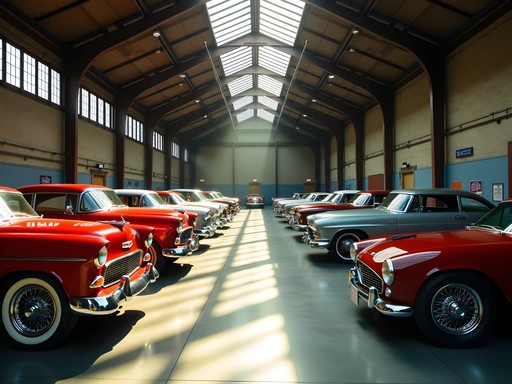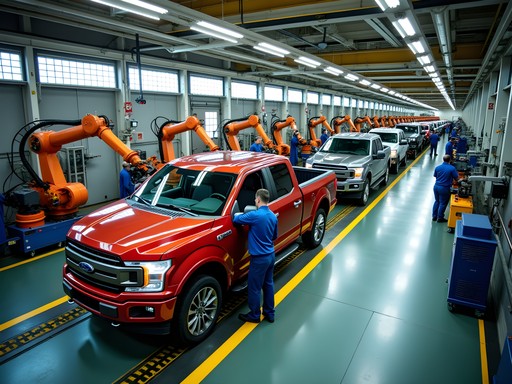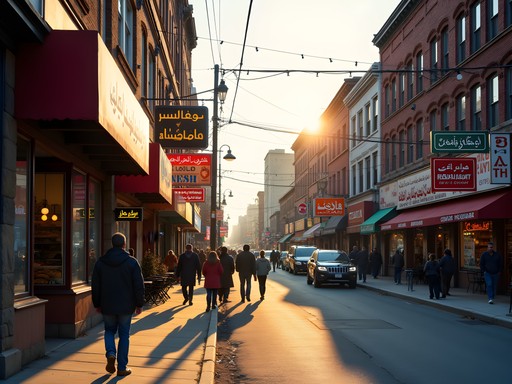Disclosure: This article contains affiliate links. We may earn a commission from purchases at no extra cost to you, which helps our travel content.
The rhythmic percussion of machinery echoes through cavernous halls while the scent of motor oil and polished metal creates an olfactory time capsule. This isn't some underground techno venue I'm exploring—it's Dearborn, Michigan, the epicenter of American industrial heritage and an unexpectedly captivating weekend destination that merges my passions for architectural photography and design innovation. Having just returned from this midwestern gem with a memory card full of images and a mind full of inspiration, I'm convinced this under-the-radar destination deserves a spot on your cultural itinerary.
The Henry Ford: America's Greatest History Attraction
Let's start with the crown jewel of Dearborn's museum landscape—The Henry Ford. This isn't merely a museum; it's a 250-acre campus comprising multiple venues that collectively tell the story of American innovation. The main museum building houses a staggering collection that extends far beyond automotive history, though the progression of Ford vehicles certainly forms its backbone.
During my visit, I found myself mesmerized by the juxtaposition of design elements—industrial minimalism meeting mid-century optimism in exhibits like Driving America. The museum's lighting design creates dramatic shadows across the gleaming vintage automobiles, offering photographers a playground of compositions.
For families, the interactive elements throughout the museum are thoughtfully designed to engage children without sacrificing the sophisticated presentation adults appreciate. My recommendation? Invest in the museum membership rather than single-day tickets if you're staying for the weekend. The value is exceptional, and you'll want to return.

💡 Pro Tips
- Arrive early (9-10am) to photograph the exhibits without crowds
- The Ford Rouge Factory Tour requires separate timed tickets—book in advance
- The museum cafe serves surprisingly good food, but bring a refillable water bottle to stay hydrated while exploring
Greenfield Village: Living History in Three Dimensions
Adjacent to the main museum lies Greenfield Village, an open-air time capsule where historical buildings from across America have been meticulously relocated and restored. This is where history transcends the glass display case and becomes a multisensory experience.
During my spring visit, the village was awakening from winter dormancy—craftspeople were firing up forges in the glass-blowing workshop, and the steam locomotives were building pressure for their daily circuits. The village operates as a living ecosystem of American innovation, from Edison's laboratory (where I spent an hour photographing the intricate equipment) to the Wright Brothers' bicycle shop.
For families with active children, Greenfield Village provides the perfect balance of education and freedom to explore. The village map is helpful, but I recommend intentionally getting lost among the historic districts. Some of my most compelling photographs came from unplanned wanderings down side paths.
Pro tip: If visiting during summer months, the portable fan I keep in my daypack proved invaluable while exploring the less-shaded areas of the village. Michigan humidity can be surprising.

💡 Pro Tips
- Take the steam locomotive around the perimeter first for orientation
- The village craftspeople are incredibly knowledgeable—engage them in conversation
- Historic food options like Eagle Tavern offer authentic period meals worth experiencing
Ford Rouge Factory Tour: Industrial Symphony in Motion
While historical exhibits provide context, witnessing contemporary manufacturing at the Ford Rouge Factory Tour delivers a visceral understanding of industrial scale that photographs simply cannot convey. The tour begins with two immersive films—the second being a multi-sensory experience complete with vibrating floors that my inner electronic music enthusiast appreciated for its technical execution.
The observation deck above the actual F-150 assembly line provides a mesmerizing view of industrial choreography. Robots and humans perform their specialized tasks in a precisely orchestrated dance of efficiency. As someone who appreciates both design and functionality, watching the marriage of body and chassis—a process that takes minutes for what once required days—was genuinely moving.
The architectural highlight is undoubtedly the factory's living roof, designed by renowned architect William McDonough. This 10.4-acre green roof system represents a fascinating intersection of industrial necessity and environmental design—a theme I've explored in my work with sustainable hospitality clients.
For the technically inclined, I recommend bringing a pair of noise-canceling headphones with transparency mode. This allows you to toggle between hearing the guide's explanation and filtering the factory noise when wanting to focus on visual details.

💡 Pro Tips
- Factory tours operate on timed tickets—book the first morning slot for smallest crowds
- Wear comfortable closed-toe shoes as required for the factory floor portion
- The observation walkway offers excellent photography angles, but no tripods allowed
The Automotive Hall of Fame: Design Evolution Showcase
Often overshadowed by its larger neighbors, the Automotive Hall of Fame offers a more intimate exploration of the personalities and design philosophies that shaped automotive history. As a graphic designer, I found the evolution of automotive branding and marketing materials particularly fascinating.
The Hall of Fame excels at storytelling through personal artifacts and design sketches—seeing the original concept drawings next to finished vehicles provides insight into the iterative creative process that resonates with my own design workflow. The building itself, with its distinctive mid-century architectural elements, deserves appreciation.
For those interested in automotive photography, the lighting here is more challenging than at The Henry Ford, but the smaller crowds allow for uninterrupted shooting. I found my light reflector invaluable for capturing details of the chrome and paintwork under the museum's spotlights.
While this venue might not hold younger children's attention as effectively as the interactive exhibits elsewhere, teens and adults with design or engineering interests will find plenty to appreciate in the thoughtfully curated collections that showcase both successes and fascinating failures in automotive innovation.

💡 Pro Tips
- Allow 1.5-2 hours for a thorough visit
- Check their calendar for rotating special exhibits
- The gift shop has unique automotive design books not found elsewhere in Dearborn
Beyond Museums: Dearborn's Cultural Landscape
Dearborn's identity extends beyond its industrial heritage. The city boasts America's largest Arab American community, creating a cultural richness that manifests in exceptional dining options. After museum days filled with industrial aesthetics, I found the contrast of traditional Middle Eastern hospitality refreshingly human-scaled.
My evenings centered around West Warren Avenue, where restaurants like Al Ameer serve Lebanese cuisine that rivals anything I've had in my travels abroad. The architectural photographer in me appreciated the juxtaposition of ornate Middle Eastern design elements against the backdrop of midwestern America.
For accommodations, I bypassed the expected chain hotels for The Dearborn Inn, a historic property commissioned by Henry Ford himself in 1931. The colonial revival architecture creates a fitting historical bookend to days spent exploring industrial heritage. While not ultra-luxury, the property maintains period charm with modern comforts.
For evening relaxation after long museum days, I recommend packing a portable massage device to soothe feet and shoulders tired from exploring the expansive museum campus. This compact recovery tool has become essential in my travel kit for cultural destinations that involve significant walking.

💡 Pro Tips
- Reserve dinner at Al Ameer in advance on weekends
- The Dearborn Inn's Colonial House rooms offer more character than the main building
- Michigan craft beers make excellent souvenirs—local shops offer shipping options
Final Thoughts
Dearborn represents something increasingly rare in our digital age—a destination that demands physical presence to truly appreciate. No virtual tour can replicate the sensation of standing beneath the massive industrial turbines at The Henry Ford or feeling the heat from the glassblowing furnaces at Greenfield Village. For families seeking educational experiences with genuine substance, these museums deliver content that resonates across generations.
As someone who has photographed architectural wonders from Alpine ski lodges to Tokyo skyscrapers, I found Dearborn's industrial aesthetics unexpectedly compelling. The city offers a distinctly American narrative of innovation, immigration, and industrial might that feels particularly relevant in our current moment of technological transformation.
Whether you're drawn by the mechanical marvels, the architectural photography opportunities, or simply a desire to understand the forces that shaped modern America, Dearborn rewards curious travelers with experiences that engage all senses. Just remember to pack comfortable shoes—appreciating the scale of American industrial ambition requires covering some serious ground.
✨ Key Takeaways
- Dearborn's museums require at least a full weekend to properly explore
- The combination of The Henry Ford Museum and Greenfield Village offers unparalleled insight into American innovation
- The city's Arab American community provides cultural depth beyond industrial heritage
- Photography opportunities abound for those interested in industrial design and architecture
- Family-friendly exhibits maintain sophistication that adults will appreciate
📋 Practical Information
Best Time to Visit
April-October for optimal outdoor experiences at Greenfield Village
Budget Estimate
$400-600 for a weekend (accommodations, tickets, meals)
Recommended Duration
2-3 days minimum
Difficulty Level
Easy
















Comments
historyteacher42
Just visited last month with my high school history class. Pro tip: download the Henry Ford app before you go - it has great self-guided tours that kept my students engaged. The presidential vehicles collection was their favorite!
Gregory Boyd
Fascinating piece, Quinn. I visited Dearborn last year during my North American industrial heritage tour. What struck me most was the contrast between the meticulously preserved historical artifacts and the cutting-edge manufacturing processes still in operation. The Rouge Factory Tour offers something uniquely American - that transparent celebration of industrial might that's simultaneously nostalgic and forward-looking. One tip for photography enthusiasts: the morning light in Greenfield Village creates stunning opportunities, especially around the craftsmen workshops. I'd recommend bringing a camera lens for versatility between indoor museum shots and outdoor village scenes.
Quinn Franklin
Thanks Gregory! Great photography tip about the morning light. I was there mid-afternoon and wished I'd had more time for different lighting conditions.
Marco Flores
Quinn, your post captures the industrial romance of Dearborn perfectly! I visited last winter during my American industrial cities tour, and The Henry Ford was a revelation. As a European, I was fascinated by how the museum contextualizes America's transition from agrarian to industrial society. The juxtaposition of Edison's Menlo Park lab next to the Wright Brothers' workshop in Greenfield Village creates this beautiful timeline of innovation. I'd recommend visitors use their audio guide which adds fantastic context to many exhibits. Also worth mentioning: the food at Michigan Café inside the museum is surprisingly good - try the tomato basil soup!
adventureone
That shot of the Model T assembly line is incredible!
coolzone
Great post! I'm planning a trip to Michigan next spring and wondering how much time I should allocate for all these museums? Is one day enough or should I plan for a weekend?
Quinn Franklin
Definitely plan for at least two full days! The Henry Ford and Greenfield Village alone could take a full day each if you want to see everything. The Rouge Factory Tour is about 3 hours with transportation time.
moonadventurer
I second that! We tried to do it all in one day last summer and it was WAY too rushed. Spread it out and enjoy.
moondiver
Wow Quinn! Your description of the Ford Rouge Factory Tour literally gave me goosebumps. It's been on my bucket list forever!
sunnyexplorer
OMG I LOVE THE HENRY FORD!!! We went there on a school trip years ago and I've been dying to go back! The way you described the 'olfactory time capsule' is EXACTLY right! That smell of history and machinery is unforgettable! Did you get to ride in any of the vintage vehicles at Greenfield Village? The Model T ride was my absolute favorite part! Your photos are making me so nostalgic right now!!! 😍
nomadguy
That Rosa Parks bus at The Henry Ford is such a powerful exhibit. Really makes history tangible.
coolzone
Great write-up! Adding this to my Michigan road trip plans for next spring.
wavenomad
Planning a trip to Detroit in November and thinking of adding Dearborn to the itinerary. How much time would you recommend to properly see The Henry Ford Museum? Is one full day enough?
Quinn Franklin
One full day is the absolute minimum for just the museum. If you want to include Greenfield Village and the Rouge Factory Tour, I'd recommend at least 2-3 days. The museum alone is massive - think Smithsonian-scale with incredible depth.
wavenomad
Thanks for the quick response! Will definitely plan for two days then. Any food recommendations in the area?
Quinn Franklin
Al-Ameer Restaurant for amazing Lebanese food - Dearborn has one of the largest Middle Eastern communities in the US. Also, don't miss Miller's Bar for what many consider Michigan's best burger!
Venture X
Premium card with 2X miles, $300 travel credit, Priority Pass